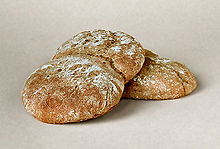South Tyrolean cuisine
The South Tyrolean cuisine has relatively little in common with the other regional cuisines in Italy. The common history with Tyrol can be felt too clearly here and the Austrian and Hungarian cuisine also has an impact on the local cuisine. Belonging to the Holy Roman Empire and the Austrian Empire has left its culinary traces.
Typical dishes and foods
Among the traditional dishes or food of peasant cuisine of South Tyrol on cereal-based counted once wheat - and oat - Mus , polenta , and spelled - and rye - bread . Typical types of bread are Schüttelbrot and Vinschgauer . In addition, corn is the basis for various soups, such as simply cooked with flour, lard, salt and water gruel , or with bacon, barley prepared and vegetable barley soup .
Vegetables that were frequently grown were traditionally cabbage , beets , potatoes and green beans . The white cabbage , which is processed into sauerkraut , is very important .
Due to the widespread livestock farming, dairy products have always been used extensively . When cooking fat was once used primarily lard . Traditionally, meat was typically processed into smoked products ( e.g. bacon or smoked sausage ).
Soups of traditional South Tyrolean cuisine are sour soup , stinging soup and Terlan wine soup ; and soups such as spleen sections , Tirteln , donuts.
Warm starters such as Schupfnudeln , Schwarzplentene dumplings , Schlutzkrapfen .
Main courses of traditional South Tyrolean cuisine are z. B. Bauernbratl , mutton , venison , bread dumplings , pork and sausages , cold cuts , called " Marende be consumed".
Traditional South Tyrolean desserts include, for example, grapes , donuts , cakes, jams and compotes.
Viticulture
The origins of viticulture in today's South Tyrol probably go back to pre-Roman times. The South Tyrolean wine-growing area, protected by DOC , extends on the slopes of the Adige Valley - mainly south of Bolzano along the Wine Route - and the Eisack Valley at altitudes between around 220 and 1000 m slm.In 2012, the entire wine-growing area comprised 5,360 hectares, making it one of the smallest Italian wine-growing regions (about 0.7% of the total area). The high-quality white wines from South Tyrol are counted among the best in Italy, and the red wines have also gained great renown since the early 1990s ; The most important varieties include the white Gewürztraminer , Ruländer and Pinot Blanc , and the red Pinot Noir , Lagrein and Vernatsch .
beer
Beer production in South Tyrol has a long tradition and dates back to 985. Forst , the largest brewery in the country, has existed since 1857 and produces various types of beer.
gastronomy
With the advent of tourism, there was a renaissance of regional cuisine in the 1960s and 1970s, for example in the context of the rapidly popularized “ Törggelen ” or the “Specialty Weeks”, which were launched a little later and tried to convey local specialties to tourists. The old Tyrolean fare was adapted to current tastes with modern preparation and processing techniques and under the influence of Italian cuisine . In gastronomy, an average of one third of the range of local cuisine, one third of Italian and one third of standard international cuisine.
literature
- Franz Maier-Bruck : From eating in the country: Tyrol; Wiener Verlag, unchanged new edition 1999; Pages 437-516; ISBN 3-218-00662-7
Individual evidence
- ^ A b c d Heinrich Gasteiger , Gerhard Wieser , Helmut Bachmann : This is how South Tyrol cooks . Athesia, Bozen 2002, ISBN 88-8266-015-X , pp. 11-17.
- ↑ Vocational school cook curriculum according to learning fields. (PDF) In: www.provinz.bz.it/bildung-sprache/berufsbildung/. Pp. 26 - 27 , accessed April 13, 2019 .
- ^ Franz Maier-Bruck: From eating in the country: Tyrol . unchanged new edition. Wiener Verlag, 1999, ISBN 3-218-00662-7 , pp. 437-516 .
- ^ Ivo Maran, Stefan Morandell: Vernatscher, Traminer, Kalterersee wine. News from South Tyrol's wine history (= writings on wine history. 188). Society for the History of Wine , Wiesbaden 2015, p. 5.
- ^ Agriculture and forestry. Autonomous Province of Bolzano - South Tyrol, State Institute for Statistics (ASTAT), accessed on March 13, 2015 .
- ↑ Falstaff Wine Guide. Austria / South Tyrol 2011 . Falstaff , Vienna 2011, ISBN 978-3-902660-14-5 , p. 688.
- ^ Josef Rohrer: Tourism in the stress of growth. The profound changes in the “wild” years . In: Gottfried Solderer (Ed.): The 20th Century in South Tyrol. Autonomy and departure . Volume IV: 1960-1979. Edition Raetia, Bozen 2002, ISBN 88-7283-183-0 , p. 254-269 .




